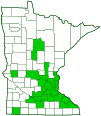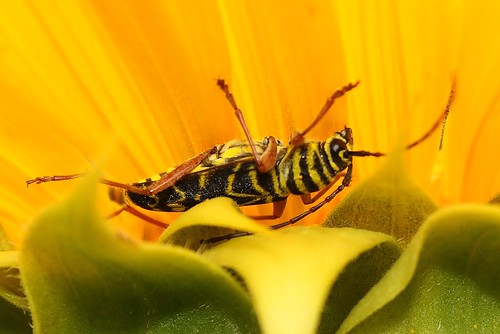locust borer
(Megacyllene robiniae)
Conservation • Description • Habitat • Ecology • Distribution • Taxonomy
Conservation Status |
|
|||||||
| IUCN Red List | not listed |
|||||||
| NatureServe | NNR - Unranked |
|||||||
| Minnesota | not listed |
|||||||
Description |
||
Locust borer is a large, colorful, round-necked longhorn beetle. It is native to the Appalachian and Ozark regions of the eastern United States, where its larval host, black locust, is also native. Black locust has been widely cultivated as an ornamental and as a soil improver in restorations. As the tree spread across North America, locust borer went with it. Locust borer is now common in Minnesota. Larvae develop within the stems of their host and are rarely seen. Adults are seen during the day from August to October on goldenrods. It is considered a serious pest of black locust. The wood of infected trees is commercially worthless, and the infected trees may die. Adults are 7⁄16″ to 1⅛″ (11 to 28 mm) long and are densely covered with short, velvety hairs. They are jet black with numerous bright yellow bands and spots, looking something like a wasp or hornet. This is probably an example of Batesian mimicry, making the beetle appear unpalatable to potential predators. The body is constricted between the thorax and the abdomen, forming a distinct rounded “neck”. The head is black with three yellow bands. The face is slanted forward, not vertical. The small antennae-like structures (palpi) emerging from the lower jaws (maxillae) are blunt at the tip, not pointed. The antennae are long, at least half as long as the body. The base of each antenna is surrounded by the compound eye. The exoskeletal plate covering the thorax (pronotum) is black, rounded, and widest near the middle when viewed from above, strongly convex when viewed from the side. It is black with yellow front, rear, and lateral margins, and two narrow yellow bands. The hardened forewings (elytra) are black with seven narrow yellow bands. The third band is strongly W-shaped. The inner one-third of each elytron is abruptly depressed. The legs are reddish. |
||
Size |
||
Total length: 7⁄16″ to 1⅛″ (11 to 28 mm) |
||
Similar Species |
||
Painted hickory borer (Megacyllene caryae) appears nearly identical but the adult emerges in the spring. It has not been recorded in Minnesota. |
||
Habitat |
||
Wherever black locust has been planted |
||
Ecology |
||
Season |
||
August to October |
||
Behavior |
||
Adults are active during the day |
||
Life Cycle |
||
|
||
Larva Food |
||
Black locust |
||
Adult Food |
||
Goldenrod flower pollen |
||
Distribution |
||||
|
Sources |
|||
| 9/*6/2023 | ||||
Occurrence |
||||
Common |
||||
Taxonomy |
|||
Order |
Coleoptera (Beetles) |
||
Suborder |
Polyphaga (Water, Rove, Scarab, Long-horned, Leaf, and Snout Beetles) |
||
Infraorder |
Cucujiformia |
||
Superfamily |
Chrysomeloidea (longhorn beetles and allies) |
||
Family |
Cerambycidae (longhorn beetles) |
||
Subfamily |
Cerambycinae (round-necked longhorn beetles) |
||
Tribe |
Clytini |
||
Genus |
Megacyllene | ||
Synonyms |
|||
Megacyllene flexuosum Megacyllene pictus |
|||
Common Names |
|||
locust borer |
|||
Glossary
Elytra
The hardened or leathery forewings of beetles used to protect the fragile hindwings, which are used for flying. Singular: elytron.
Maxillae
Paired mouth structures of arthropods located immediately behind the mandible and used for tasting and manipulating food. “Under-jaws”.
Palp
Short for pedipalp. A segmented, finger-like process of an arthropod; one is attached to each maxilla and two are attached to the labium. They function as sense organs in spiders and insects, and as weapons in scorpions. Plural: palpi or palps.
Pronotum
The exoskeletal plate on the upper side of the first segment of the thorax of an insect.
Visitor Photos |
|||||
Share your photo of this insect. |
|||||
| This button not working for you? Simply email us at info@MinnesotaSeasons.com. Attach one or more photos and, if you like, a caption. |
|||||
Alfredo Colon |
|||||
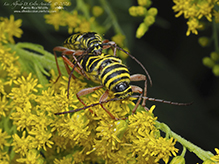 |
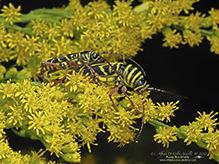 |
||||
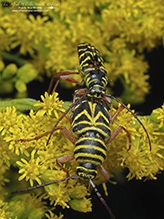 |
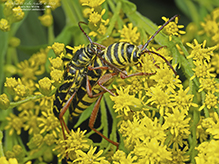 |
||||
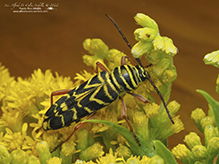 |
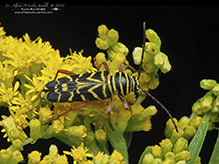 |
||||
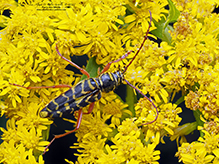 |
 |
||||
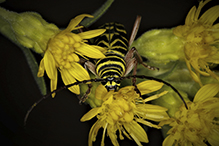 |
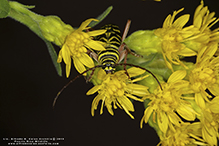 |
||||
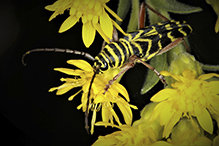 |
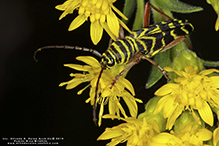 |
||||
Greg Watson |
|||||
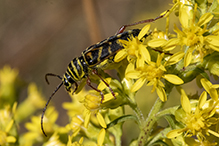 |
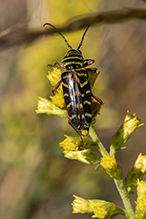 |
||||
MinnesotaSeasons.com Photos |
|||||
|
|||||

Visitor Videos |
|||
Share your video of this insect. |
|||
| This button not working for you? Simply email us at info@MinnesotaSeasons.com. Attach a video, a YouTube link, or a cloud storage link. |
|||
Other Videos |
|||
| Locust borer beetle eating pollen in flowers GoTrails |
|||
About
Oct 6, 2019 Locust borer beetle crawling / walking and eating / feeding on pollen / nectar of bright yellow flowers of goldenrod plants | Bee-like, Wasp-like | Megacyllene robiniae, Robinia borulo, cyllène du robinier | Coleoptera, Käfer, coleópteros, escarabajos, coléoptères, coleotteri | serious pest of the black locust tree | Wildlife, Animal Behavior, Nature, Insect facts | #GoTrails, #beetle, #arthropod, #insect, #insects, #beetles, #animalforkids | HD video, nature sounds |
|||
| Longhorned Beetle Wasp Mimic - Locust borer Stoil Ivanov |
|||
About
Sep 1, 2019 Locust borer ( Megacyllene robiniae ) Filmed on 8-31-2019 McDonald Woods Forest Preserve ,Lindenhurst Illinois. Good example of Batesian mimicry. Pest of the Black locust tree , but so beautiful. |
|||
| Locust Borer, Part 1 - August 25, 2013 Don Gagnon |
|||
About
Aug 26, 2013 Locust Borer (Megacyllene robiniae), Pottersville Woods, Somerset, Massachusetts, Sunday morning, August 25, 2013, 12:57 PM - Canon PowerShot SX50 HS MVI_43272; 1:11 min. |
|||


Created: 2/12/2020
Last Updated:
